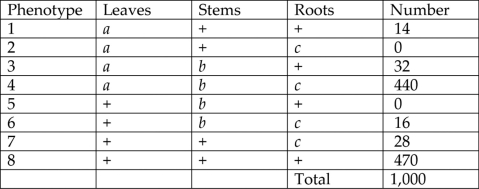A) Women can never have this condition.
B) One-half of the daughters of an affected man would have this condition.
C) One-fourth of the daughters of an affected father and a carrier mother could have this condition.
D) Very rarely: it is rare that an affected male would mate with a carrier female.
E) Only if a woman is XXX could she have this condition.
G) A) and C)
Correct Answer

verified
Correct Answer
verified
Multiple Choice
When Thomas Hunt Morgan crossed his red-eyed F1 generation flies to each other, the F2 generation included both red- and white-eyed flies. Remarkably, all the white-eyed flies were male. What was the explanation for this result?
A) The gene involved is on the Y chromosome.
B) The gene involved is on the X chromosome.
C) The gene involved is on an autosome, but only in males.
D) Eye color in flies is a multifactorial trait.
F) B) and C)
Correct Answer

verified
Correct Answer
verified
Multiple Choice
Please use the following information to answer the question(s) below.
A plantlike organism on the planet Pandora can have three recessive genetic traits: bluish leaves, due to an allele (a) of gene A; a feathered stem, due to an allele (b) of gene B; and hollow roots due to an allele (c) of gene C. The three genes are linked and recombine.
A geneticist did a testcross with an organism that had been found to be heterozygous for the three recessive traits and was able to identify progeny of the phenotypic distribution (+ = wild type) shown in Figure 12.3.  Figure 12.3
-In which progeny phenotypes has there been recombination between genes A and B?
Figure 12.3
-In which progeny phenotypes has there been recombination between genes A and B?
A) 1, 2, 5, and 6
B) 1, 3, 6, and 7
C) 2, 4, 5, and 8
D) 2, 3, 5, and 7
E) in all 8 of them
G) A) and B)
Correct Answer

verified
Correct Answer
verified
Multiple Choice
Which of the following is known as a Philadelphia chromosome?
A) a human chromosome 22 that has had a specific translocation
B) a human chromosome 9 that is found only in one type of cancer
C) an animal chromosome found primarily in the mid-Atlantic area of the United States
D) an imprinted chromosome that always comes from the mother
F) A) and B)
Correct Answer

verified
Correct Answer
verified
Multiple Choice
Which of the following statements correctly describes linkage?
A) The closer two genes are on a chromosome, the lower the probability that a crossover will occur between them.
B) The observed frequency of recombination of two genes that are far apart from each other has a maximum value of 100%.
C) All of the traits that Mendel studied-seed color, pod shape, flower color, and others-are due to genes linked on the same chromosome.
D) Linked genes are found on different chromosomes.
F) B) and C)
Correct Answer

verified
Correct Answer
verified
Multiple Choice
In cats, black fur color is caused by an X-linked allele; the other allele at this locus causes orange color. The heterozygote is tortoiseshell. What kinds of offspring would you expect from the cross of a black female and an orange male?
A) tortoiseshell females; tortoiseshell males
B) black females; orange males
C) orange females; orange males
D) tortoiseshell females; black males
E) orange females; black males
G) B) and E)
Correct Answer

verified
Correct Answer
verified
Showing 41 - 46 of 46
Related Exams